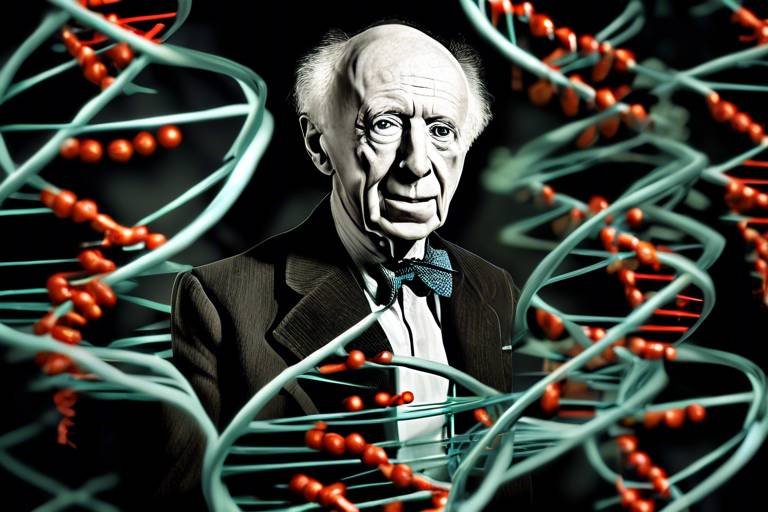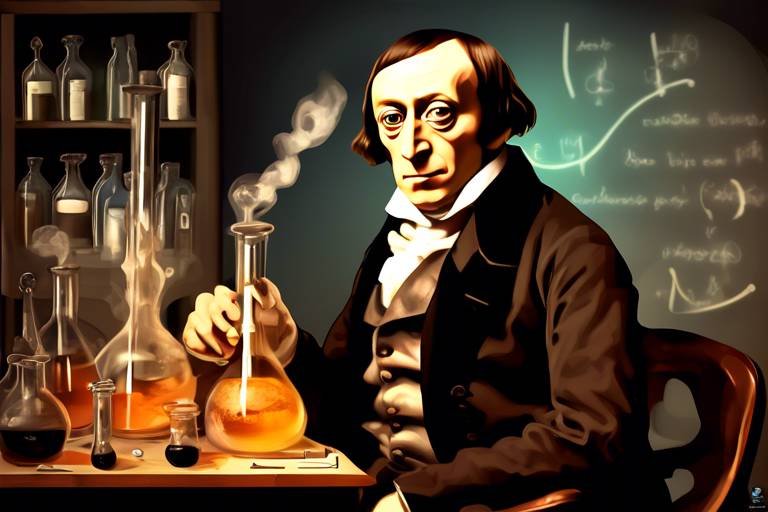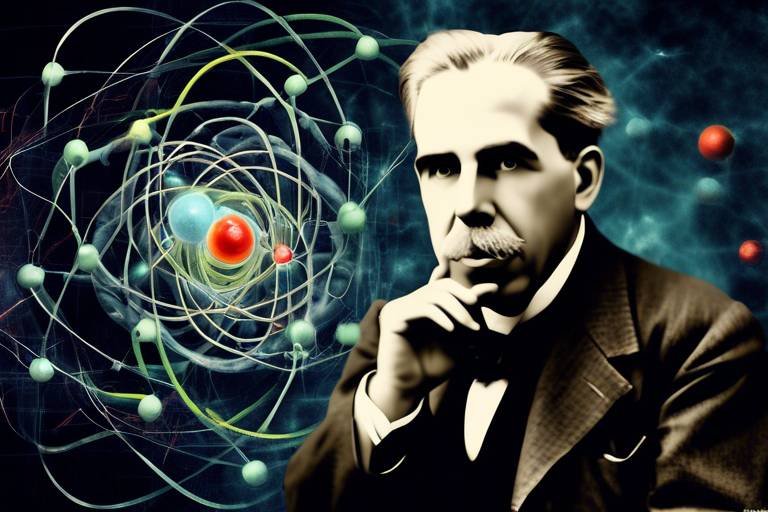The Theories of Ludwig Boltzmann in Statistical Mechanics
When we think about the universe, it can often feel like a chaotic jumble of particles, energy, and forces. Yet, thanks to the profound insights of Ludwig Boltzmann, we have a lens through which we can view this chaos with clarity and understanding. Boltzmann, an Austrian physicist, played a pivotal role in the development of statistical mechanics, a branch of physics that connects the microscopic world of atoms and molecules with the macroscopic properties we observe in everyday life. His work laid the groundwork for modern physics, influencing not just thermodynamics, but also quantum mechanics and cosmology.
At the heart of Boltzmann's theories is the idea that the behavior of large numbers of particles can be understood through statistical methods. Imagine trying to predict the weather. You wouldn't just look out the window; you'd analyze vast amounts of data, from temperature to humidity, to make an informed forecast. Similarly, Boltzmann proposed that by examining the collective behavior of particles, we could derive meaningful insights about temperature, pressure, and other thermodynamic properties. This approach was revolutionary, as it shifted the focus from individual particles to the statistical distribution of many particles, thus bridging the gap between the micro and macro worlds.
One of Boltzmann's most significant contributions is his formulation of entropy. In simple terms, entropy can be thought of as a measure of disorder or randomness in a system. Boltzmann's famous equation, S k log W, where S represents entropy, k is the Boltzmann constant, and W is the number of possible microscopic configurations of a system, elegantly encapsulates this concept. It shows how the microscopic states of a system relate directly to its macroscopic properties, providing a statistical interpretation of the second law of thermodynamics. This law, which states that the total entropy of an isolated system can never decrease over time, highlights the natural tendency towards disorder in the universe.
Furthermore, Boltzmann's work introduced the Boltzmann equation, which describes how the distribution of particles in a gas evolves over time. This equation is not just a theoretical construct; it has profound implications across various fields. For instance, in astrophysics, it helps model the behavior of stellar gases, while in aerodynamics, it is crucial for understanding how air interacts with solid objects. However, it's important to note that the Boltzmann equation has its limitations. In systems where particles exhibit strong correlations or in the realm of quantum mechanics, alternative approaches are often required to accurately describe the behavior of particles.
Boltzmann's legacy is not just confined to his equations and theories; it extends to the very fabric of modern physics. His ideas have paved the way for significant advancements in understanding complex systems, from the behavior of gases to the intricacies of quantum states. The intersection of Boltzmann's statistical mechanics with quantum theory has been particularly fruitful, leading to discoveries such as Bose-Einstein condensation and Fermi-Dirac statistics. These concepts have enriched our understanding of how particles behave at extremely low temperatures and in high-energy environments.
In summary, Ludwig Boltzmann's contributions to statistical mechanics are monumental. His theories not only revolutionized our understanding of thermodynamics but also established a framework that continues to inform research across various scientific disciplines. As we delve deeper into the mysteries of the universe, Boltzmann's insights remind us of the beauty of statistical approaches in unveiling the complexities of nature.
- What is statistical mechanics? Statistical mechanics is a branch of physics that uses statistical methods to relate the microscopic properties of particles to the macroscopic properties of materials.
- How did Boltzmann contribute to thermodynamics? Boltzmann's formulation of entropy provided a statistical interpretation of thermodynamic laws, linking the behavior of individual particles to observable macroscopic phenomena.
- What is the significance of the Boltzmann equation? The Boltzmann equation describes the statistical distribution of particles in a gas, offering insights into transport phenomena and equilibrium states.
- Are there limitations to the Boltzmann equation? Yes, the Boltzmann equation has limitations in systems with strong correlations or quantum effects, necessitating alternative approaches in statistical mechanics.

Introduction to Statistical Mechanics
Statistical mechanics is like the bridge that connects the tiny, chaotic world of atoms and molecules to the organized, observable phenomena we see in our everyday lives. Imagine trying to understand a bustling city by examining each individual person; that’s how microscopic particle behavior works. Statistical mechanics takes a step back and looks at the crowd, allowing us to decipher the underlying rules governing the entire system. By employing statistical methods and probability theory, it provides a framework that helps us understand how the collective behavior of particles leads to the macroscopic properties of matter.
At its core, statistical mechanics seeks to explain how the microscopic details of a system—like the positions and velocities of individual particles—translate into the observable properties we measure, such as temperature, pressure, and volume. For example, think about a gas in a balloon. While we can feel the pressure and see the volume, statistical mechanics tells us that this behavior arises from countless particles colliding and moving in random directions. By analyzing these interactions statistically, we can derive laws that govern the behavior of gases, liquids, and solids.
One of the most fascinating aspects of statistical mechanics is its ability to explain thermodynamics, which is often perceived as a set of empirical laws. For instance, the laws of thermodynamics dictate that energy cannot be created or destroyed, but rather transformed from one form to another. Statistical mechanics provides a deeper understanding of why this is the case by linking these macroscopic laws to the microscopic world. It shows us that the randomness and disorder at the particle level give rise to the order we observe in larger systems.
To illustrate the significance of statistical mechanics further, let’s consider some key aspects:
- Connection to Thermodynamics: Statistical mechanics lays the groundwork for thermodynamic principles, revealing how energy transitions occur at the molecular level.
- Understanding Phase Transitions: It helps explain phenomena like boiling and melting by analyzing how particles behave under varying conditions.
- Predicting Behavior: By using statistical distributions, we can predict how a gas will behave under different pressures and temperatures.
In summary, statistical mechanics is not just a theoretical framework; it's a powerful tool that allows physicists to make sense of the complex interactions that govern the physical world. It serves as the backbone for many scientific disciplines, from chemistry to astrophysics, and continues to evolve as we deepen our understanding of the universe.

Boltzmann's Entropy Concept
Ludwig Boltzmann's formulation of entropy was nothing short of revolutionary. Before his work, entropy was largely viewed through the lens of classical thermodynamics, often seen as an abstract concept without a clear connection to the microscopic world. Boltzmann, however, dared to bridge this gap, establishing a profound link between the microscopic states of a system and its macroscopic properties. He introduced a statistical interpretation of entropy, which fundamentally altered our understanding of the second law of thermodynamics.
At the heart of Boltzmann's entropy concept is the famous equation:
S k * log(W)
In this equation, S represents entropy, k is the Boltzmann constant, and W denotes the number of microscopic configurations corresponding to a thermodynamic system's macroscopic state. This relationship implies that the greater the number of possible microscopic arrangements, the higher the entropy of the system. In simpler terms, think of a room filled with gas particles. If the particles can be arranged in numerous ways, the system is in a state of high entropy. Conversely, if the particles are confined to a small volume, the entropy is low.
Boltzmann's insight not only provided a mathematical framework for understanding entropy but also illustrated how it relates to the concept of disorder. In essence, systems tend to evolve towards states of higher entropy, which can be likened to a messy room that becomes increasingly disordered over time. This tendency towards disorder is a fundamental aspect of nature, explaining why we observe irreversible processes in everyday life.
To further appreciate Boltzmann's contribution, consider the implications of his entropy concept in various scientific fields:
- Thermodynamics: Boltzmann's ideas helped solidify the second law of thermodynamics, stating that the total entropy of an isolated system can never decrease over time.
- Statistical Mechanics: His work laid the groundwork for statistical mechanics, enabling scientists to describe and predict the behavior of systems with a large number of particles.
- Cosmology: Boltzmann's theories have implications in cosmology, particularly in understanding the evolution of the universe and the distribution of matter.
Furthermore, Boltzmann's entropy concept has sparked numerous discussions and debates among physicists. Some have even extended his ideas into the realm of information theory, where entropy is interpreted as a measure of uncertainty or information content. This connection highlights the versatility of Boltzmann's work and its relevance across various disciplines.
In summary, Boltzmann's formulation of entropy not only revolutionized thermodynamics but also provided a robust framework for understanding the microscopic underpinnings of macroscopic phenomena. His legacy continues to resonate in modern physics, reminding us that at the core of every physical system lies a complex interplay of particles, probabilities, and the inevitable march toward disorder.

The Boltzmann Equation
The Boltzmann equation is a fundamental equation in statistical mechanics that describes the statistical distribution of particles in a gas. It serves as a bridge between the microscopic behavior of individual particles and the macroscopic properties of the gas as a whole. Imagine a bustling city where each person represents a gas particle; the Boltzmann equation helps us understand how their movements and interactions lead to the overall behavior of the city. This equation captures the dynamics of particle interactions, providing insights into how gases behave under various conditions, including transport phenomena like diffusion and viscosity.
At its core, the Boltzmann equation can be expressed mathematically as:
∂f/∂t + v · ∇f C(f)
In this equation:
- f represents the distribution function of particles, which gives the number of particles at a given position and velocity.
- t is time, indicating how the distribution changes over time.
- v is the velocity of the particles.
- ∇f denotes the spatial gradient of the distribution function, showing how the distribution varies in space.
- C(f) is the collision term, which accounts for the changes in the distribution due to particle interactions.
This equation is not just a theoretical construct; it has practical applications across various fields. For instance, in astrophysics, it helps model the behavior of stellar gases, while in aerodynamics, it aids in understanding how air interacts with solid objects, such as aircraft. Additionally, in kinetic theory, the Boltzmann equation plays a crucial role in predicting the behavior of gases in non-equilibrium states.
However, it’s important to note that the Boltzmann equation is not without its challenges. In systems where particles exhibit strong correlations or quantum effects, the traditional Boltzmann equation may fall short, necessitating the development of alternative approaches. These limitations highlight the ongoing evolution of statistical mechanics, as researchers continue to explore and refine our understanding of particle dynamics.
In summary, the Boltzmann equation is a powerful tool in the realm of statistical mechanics, offering profound insights into the behavior of gases. Its ability to connect microscopic interactions with macroscopic phenomena underscores its significance in both theoretical and applied physics.
- What is the significance of the Boltzmann equation? The Boltzmann equation provides a statistical framework to understand the behavior of gas particles, linking microscopic interactions to macroscopic properties.
- How is the Boltzmann equation applied in real life? It is used in various fields such as astrophysics, aerodynamics, and kinetic theory to model gas behavior and predict outcomes in complex systems.
- What are the limitations of the Boltzmann equation? The equation may struggle with systems that exhibit strong correlations or quantum effects, leading to the need for more advanced models.

Applications of the Boltzmann Equation
The Boltzmann equation is not just a theoretical construct; it serves as a powerful tool across various scientific domains. Its applications extend far beyond the realm of simple gas laws, touching on complex systems where particle interactions dictate behavior. One of the most significant areas is astrophysics, where the Boltzmann equation helps in modeling the behavior of stellar gases and the dynamics of galaxies. By analyzing the distribution of particles, astrophysicists can predict how stars will form, evolve, and interact within the vast cosmos.
In the field of aerodynamics, the Boltzmann equation is crucial for understanding the flow of air over wings and the behavior of gases at high speeds. It allows engineers to simulate and analyze the effects of turbulence and drag, which are vital for designing efficient aircraft and vehicles. The insights gained from these simulations can lead to innovations in technology that enhance performance and safety.
Furthermore, the Boltzmann equation plays a pivotal role in kinetic theory, which is foundational for understanding transport phenomena such as heat conduction, diffusion, and viscosity. By using the equation to model how particles collide and scatter, scientists can derive macroscopic properties from microscopic behaviors. This is particularly useful in materials science, where understanding the thermal and mechanical properties of materials at the molecular level can lead to the development of new materials with desirable characteristics.
To illustrate the versatility of the Boltzmann equation, consider the following table that summarizes its applications across different fields:
| Field | Application |
|---|---|
| Astrophysics | Modeling stellar gases and galaxy dynamics |
| Aerodynamics | Simulating airflow and analyzing drag |
| Kinetic Theory | Understanding heat conduction and diffusion |
| Materials Science | Developing new materials through molecular behavior analysis |
In addition to these fields, the Boltzmann equation is also applied in biophysics, where it helps in understanding molecular interactions in biological systems. For instance, it can be used to model how proteins fold and interact with other molecules, which is crucial for drug design and understanding diseases at a molecular level.
In summary, the Boltzmann equation is a cornerstone of statistical mechanics with applications that span a wide range of scientific disciplines. Its ability to bridge the gap between microscopic behaviors and macroscopic phenomena makes it an indispensable tool in modern physics and engineering.
- What is the Boltzmann equation? The Boltzmann equation describes the statistical distribution of particles in a gas, capturing the dynamics of their interactions.
- How does the Boltzmann equation apply to real-world scenarios? It is used in various fields, including astrophysics, aerodynamics, and materials science, to model complex systems and predict behaviors.
- What is the significance of Boltzmann's work in modern physics? Boltzmann's contributions laid the foundation for statistical mechanics, which is crucial for our understanding of thermodynamics and quantum mechanics.

Limitations of the Boltzmann Equation
The Boltzmann equation, while revolutionary, is not without its limitations. One of the most significant challenges arises in systems where strong correlations exist among particles. In such cases, the assumptions of independence and randomness that underpin the Boltzmann framework begin to break down. This can lead to inaccuracies in predicting the behavior of gases, especially when interactions become complex and non-linear.
Another critical limitation is observed in quantum systems. The Boltzmann equation is rooted in classical mechanics, which means it does not adequately address phenomena that arise from quantum effects. For instance, in systems where quantum statistics dominate, such as in Bose-Einstein condensates or Fermi gases, the classical approach fails to capture the unique behaviors exhibited by particles at extremely low temperatures. This discrepancy highlights the need for a more comprehensive theoretical framework that integrates both quantum mechanics and statistical mechanics.
Moreover, the Boltzmann equation assumes that the system reaches a state of equilibrium, which may not always be the case in real-world scenarios. Many physical systems experience fluctuations and external forces that prevent them from achieving equilibrium, thereby complicating the application of the Boltzmann equation. These limitations necessitate the exploration of alternative approaches, such as the use of quantum statistical mechanics or non-equilibrium statistical mechanics, which can provide a more accurate representation of complex systems.
In summary, while the Boltzmann equation has provided profound insights into statistical mechanics, its limitations in handling strongly correlated systems, quantum phenomena, and non-equilibrium states remind us that the journey of understanding the universe is ongoing. As physicists continue to explore the boundaries of these theories, they pave the way for new discoveries that could redefine our understanding of matter and energy.
- What is the Boltzmann equation used for?
The Boltzmann equation is used to describe the statistical behavior of a thermodynamic system not in equilibrium, particularly to model the distribution of particles in a gas. - Why is the Boltzmann equation important?
It plays a crucial role in connecting microscopic particle interactions with macroscopic physical properties, allowing for a deeper understanding of thermodynamics and statistical mechanics. - What are some applications of the Boltzmann equation?
The equation has applications in various fields, including astrophysics, aerodynamics, and kinetic theory, helping to analyze complex systems and predict their behaviors. - What are the limitations of the Boltzmann equation?
Its limitations include difficulties in systems with strong correlations, inadequacy in quantum contexts, and assumptions of equilibrium that may not hold in real-world situations.

Boltzmann's H-Theorem
Ludwig Boltzmann's H-theorem is a pivotal concept in statistical mechanics that delves into the nature of entropy and its relationship with the second law of thermodynamics. At its core, the H-theorem provides a statistical basis for understanding how entropy increases in isolated systems, which is a fundamental aspect of thermodynamic processes. But what does this really mean? Imagine a room filled with gas particles; initially, they might be concentrated in one corner. Over time, due to random motion, these particles spread out, leading to a more uniform distribution. This process is a manifestation of entropy increasing, and Boltzmann's H-theorem mathematically describes this tendency towards disorder.
The essence of the H-theorem lies in its demonstration of how macroscopic irreversibility emerges from microscopic reversibility. Essentially, while the individual particles in a gas may behave in reversible ways, the collective behavior leads to irreversible processes, such as the spreading of gas throughout the room. Boltzmann introduced a function, denoted as H, which represents the entropy of a system in terms of the distribution of particles across different energy states. As time progresses, the value of H tends to increase, reflecting the second law of thermodynamics that states that in an isolated system, entropy will never decrease.
To better illustrate this concept, consider the following table that summarizes the relationship between microscopic states and macroscopic properties:
| Microscopic State | Macroscopic Property | Entropy Change |
|---|---|---|
| Ordered arrangement of particles | Low entropy | Decreases |
| Random arrangement of particles | High entropy | Increases |
In the context of the H-theorem, the increase of entropy can be thought of as a natural tendency towards chaos. Just like how a deck of cards, when shuffled, becomes disordered, the particles in a gas will naturally spread out and mix over time, leading to higher entropy. This analogy helps to grasp the concept that while individual interactions may be reversible, the overall trend is towards a state of greater disorder.
However, it is important to note the limitations of the H-theorem. While it provides a robust framework for understanding many thermodynamic processes, it does not account for certain phenomena, particularly those involving quantum mechanics or systems with strong correlations between particles. These limitations have led to further developments in statistical mechanics, expanding our understanding of complex systems.
In summary, Boltzmann's H-theorem is not just a theoretical construct; it is a profound insight into the very fabric of our universe. By connecting the microscopic behavior of particles with macroscopic thermodynamic properties, Boltzmann laid the groundwork for a deeper understanding of entropy and irreversible processes, influencing countless fields of physics and beyond.
- What is the significance of Boltzmann's H-theorem?
It provides a statistical basis for the increase of entropy in isolated systems, linking microscopic particle behavior to macroscopic irreversibility. - How does the H-theorem relate to the second law of thermodynamics?
The H-theorem illustrates that in an isolated system, entropy tends to increase, aligning with the second law that states entropy will not decrease. - Are there limitations to the H-theorem?
Yes, the H-theorem does not account for quantum effects or systems with strong particle correlations, leading to the development of alternative approaches.

Impact on Modern Physics
When we dive into the realm of modern physics, it's impossible to overlook the profound impact of Ludwig Boltzmann's theories. His groundbreaking ideas have not only shaped our understanding of thermodynamics but have also paved the way for advancements in various fields, including quantum mechanics and cosmology. Imagine standing at the edge of a vast ocean of knowledge, where each wave represents a different scientific breakthrough, and Boltzmann's theories are the currents that guide our exploration of this ocean.
Boltzmann's work on statistical mechanics provides a crucial framework that connects the microscopic behavior of particles to the macroscopic properties of materials. This connection is vital for understanding how energy is distributed among particles, which is foundational for explaining phenomena such as heat capacity and phase transitions. By introducing the concept of entropy as a measure of disorder, Boltzmann offered a statistical interpretation of the second law of thermodynamics, which states that the total entropy of an isolated system can never decrease over time. This insight has far-reaching implications, not just in physics, but also in chemistry and biology, influencing how we comprehend processes ranging from chemical reactions to evolutionary dynamics.
Moreover, Boltzmann's theories have significantly influenced the development of quantum mechanics. The intersection of statistical mechanics and quantum theory has led to a deeper understanding of various phenomena, such as Bose-Einstein condensation and Fermi-Dirac statistics. These concepts describe how particles behave at extremely low temperatures and how they occupy energy states, respectively. Without Boltzmann's pioneering work, the field of quantum mechanics might not have evolved as rapidly or as robustly as it has.
To illustrate the impact of Boltzmann's theories on modern physics, consider the following table that summarizes some key areas influenced by his work:
| Field | Influence of Boltzmann's Theories |
|---|---|
| Thermodynamics | Foundation for understanding entropy and energy distribution. |
| Quantum Mechanics | Insights into particle statistics and behavior at low temperatures. |
| Cosmology | Framework for understanding the evolution of the universe and cosmic microwave background radiation. |
| Statistical Physics | Establishment of statistical methods to describe complex systems. |
In the context of cosmology, Boltzmann's theories help explain the behavior of matter and energy in the universe. For instance, his insights into the statistical distribution of particles are essential for understanding the cosmic microwave background radiation, which is a remnant of the early universe. This radiation provides a snapshot of the universe when it was just a few hundred thousand years old, and Boltzmann's work on statistical mechanics helps us interpret this data.
In conclusion, Ludwig Boltzmann's contributions to modern physics are nothing short of revolutionary. His theories have not only laid the groundwork for our understanding of various physical phenomena but have also inspired generations of physicists to explore the intricate dance of particles that govern our universe. As we continue to unravel the mysteries of the cosmos, Boltzmann's legacy remains a guiding light, reminding us of the power of statistical approaches in understanding the natural world.

Connection to Quantum Mechanics
The relationship between Ludwig Boltzmann's statistical mechanics and quantum mechanics is a fascinating intersection that has significantly advanced our understanding of the physical world. At first glance, one might think of statistical mechanics as a framework dealing primarily with classical systems, but Boltzmann's ideas have seamlessly woven into the fabric of quantum theory, creating a rich tapestry of concepts that explain the behavior of particles at both microscopic and macroscopic scales.
To grasp this connection, it's essential to understand how Boltzmann's statistical approach complements quantum mechanics. In classical mechanics, particles are treated as distinguishable entities, allowing us to predict their behavior through deterministic laws. However, in the quantum realm, particles like electrons and photons exhibit wave-particle duality, leading to phenomena that defy classical intuition. Here, Boltzmann's statistical methods provide a powerful tool to handle the inherent uncertainties of quantum systems.
One of the standout contributions of Boltzmann’s work to quantum mechanics is the development of the concept of quantum statistics. This includes two key distributions: Bose-Einstein statistics, which apply to indistinguishable particles known as bosons, and Fermi-Dirac statistics, which govern the behavior of fermions. These statistical distributions describe how particles occupy energy states, revealing how temperature and other macroscopic properties emerge from the underlying quantum states.
For example, consider the phenomenon of Bose-Einstein condensation, where a group of bosons occupies the same quantum state at very low temperatures, leading to unique properties such as superfluidity. This concept directly stems from Boltzmann's insights into particle distributions and entropy, demonstrating how quantum mechanics can be understood through a statistical lens.
Moreover, Boltzmann's H-theorem, which addresses the increase of entropy in isolated systems, has found relevance in quantum mechanics as well. The H-theorem illustrates that even in a quantum system, the tendency toward higher entropy reflects the statistical nature of particle interactions, bridging the gap between classical and quantum thermodynamics.
Another critical aspect of Boltzmann's legacy in quantum mechanics is the acknowledgment of irreversibility. While quantum mechanics often emphasizes reversible processes, Boltzmann's statistical perspective sheds light on how macroscopic irreversibility arises from the collective behavior of countless particles, a concept that remains vital in understanding thermodynamic processes in quantum systems.
In summary, the connection between Boltzmann's statistical mechanics and quantum mechanics is not just a historical footnote; it represents a foundational pillar that supports much of modern theoretical physics. As physicists continue to explore the quantum realm, Boltzmann’s principles remain instrumental in deciphering the complexities of nature, proving that even the smallest particles follow the statistical rules that govern the universe.
- What is the significance of Boltzmann's work in modern physics?
Boltzmann's theories laid the groundwork for statistical mechanics, influencing thermodynamics, quantum mechanics, and cosmology. - How does Boltzmann's entropy relate to quantum mechanics?
Boltzmann's entropy concept helps explain the statistical nature of particle distributions in quantum systems, particularly in phenomena like Bose-Einstein condensation. - What are Bose-Einstein and Fermi-Dirac statistics?
These are statistical distributions that describe how indistinguishable particles (bosons and fermions) occupy energy states in quantum mechanics. - Can Boltzmann's theories be applied to all physical systems?
While Boltzmann's theories are widely applicable, they have limitations in systems with strong correlations or significant quantum effects.

Legacy of Ludwig Boltzmann
Ludwig Boltzmann's legacy is a beacon of inspiration for physicists and scientists across various disciplines. His revolutionary ideas laid the groundwork for modern statistical mechanics, fundamentally altering our understanding of thermodynamics and the behavior of gases. Boltzmann's work serves as a reminder of the power of abstract thinking and the importance of connecting microscopic behavior to macroscopic phenomena. His contributions have not only shaped theoretical physics but also paved the way for practical applications in numerous fields.
One of the most significant aspects of Boltzmann's legacy is his emphasis on probability and statistics in describing physical systems. This approach has influenced various scientific domains, leading to breakthroughs in areas such as chemistry, biology, and even economics. For instance, the application of statistical methods in predicting molecular behavior has become essential in fields like biophysics and materials science.
Moreover, Boltzmann's ideas have found resonance in the realm of quantum mechanics. The intersection of his statistical mechanics with quantum theory has led to profound insights into phenomena such as Bose-Einstein condensation and Fermi-Dirac statistics. These concepts have not only expanded our understanding of the microscopic world but also enhanced our grasp of complex systems, from superconductors to superfluids.
In addition to his scientific contributions, Boltzmann's philosophical outlook on science and nature has left a lasting impact. He championed the idea that the universe operates on probabilistic principles, challenging deterministic views that dominated his time. This perspective encourages scientists to embrace uncertainty and complexity, fostering a more nuanced understanding of natural phenomena.
To illustrate the profound impact of Boltzmann's work, consider the following table that highlights some of the key areas influenced by his theories:
| Field | Influence |
|---|---|
| Thermodynamics | Foundation of statistical interpretation of entropy |
| Astrophysics | Modeling stellar evolution and cosmic background radiation |
| Chemistry | Understanding reaction rates and molecular interactions |
| Biophysics | Analyzing protein folding and molecular dynamics |
| Quantum Mechanics | Development of statistics for indistinguishable particles |
In summary, Ludwig Boltzmann's legacy is a testament to the enduring power of innovative thinking in science. His work continues to inspire new generations of researchers, emphasizing the importance of statistical approaches in understanding the complexities of the universe. As we delve deeper into the mysteries of nature, Boltzmann's insights remind us that embracing uncertainty and exploring the statistical nature of reality can lead to remarkable discoveries.
What is Ludwig Boltzmann best known for?
Ludwig Boltzmann is best known for his foundational contributions to statistical mechanics and his formulation of the concept of entropy, which links microscopic states to macroscopic thermodynamic properties.
How did Boltzmann's work influence modern physics?
Boltzmann's theories have profoundly influenced modern physics by establishing statistical mechanics as a cornerstone of theoretical physics, shaping our understanding of thermodynamics, quantum mechanics, and cosmology.
What is the significance of the Boltzmann equation?
The Boltzmann equation describes the statistical distribution of particles in a gas, capturing the dynamics of particle interactions and providing insights into transport phenomena and equilibrium states.
Are there any limitations to the Boltzmann equation?
Yes, while the Boltzmann equation has been highly successful, it has limitations in systems with strong correlations or quantum effects, leading to the development of alternative approaches in statistical mechanics.
Frequently Asked Questions
- What is statistical mechanics?
Statistical mechanics is a branch of physics that connects the microscopic behavior of individual particles to the macroscopic properties of materials. It uses statistical methods and probability theory to explain how large numbers of particles interact and how these interactions lead to observable phenomena like temperature and pressure.
- How did Ludwig Boltzmann contribute to the field?
Ludwig Boltzmann made significant contributions to statistical mechanics, particularly through his formulation of entropy and the Boltzmann equation. His work helped to establish a statistical interpretation of the second law of thermodynamics, linking the microscopic states of a system to its macroscopic properties.
- What is the Boltzmann equation?
The Boltzmann equation is a fundamental equation in statistical mechanics that describes the statistical distribution of particles in a gas. It captures how particles interact and evolve over time, providing insights into transport phenomena and the approach to equilibrium.
- What are the applications of the Boltzmann equation?
The Boltzmann equation has numerous applications across various fields including astrophysics, aerodynamics, and kinetic theory. It helps in modeling complex systems, predicting their behavior under different conditions, and understanding how particles move and interact in gases.
- What is Boltzmann's H-theorem?
Boltzmann's H-theorem provides a statistical foundation for the increase of entropy in isolated systems. It illustrates how macroscopic irreversibility arises from microscopic reversibility, showing that as particles interact over time, systems tend to evolve towards a state of higher entropy.
- How has Boltzmann's work impacted modern physics?
Boltzmann's theories have had a profound impact on modern physics, influencing our understanding of thermodynamics, quantum mechanics, and cosmology. His work established statistical mechanics as a crucial part of theoretical physics, shaping how scientists approach complex physical systems.
- What is the connection between Boltzmann's theories and quantum mechanics?
The intersection of Boltzmann's statistical mechanics with quantum theory has led to significant advancements in understanding phenomena like Bose-Einstein condensation and Fermi-Dirac statistics. This connection has enriched both fields and provided deeper insights into the behavior of particles at different energy levels.
- What is Boltzmann's legacy in physics?
Ludwig Boltzmann's legacy continues to inspire physicists today. His ideas form the foundation for ongoing research in statistical mechanics and thermodynamics, emphasizing the importance of statistical approaches in understanding the natural world and the behavior of complex systems.



















